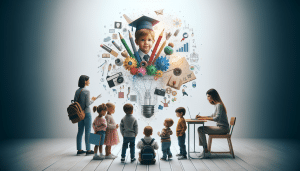Why Digital Literacy Matters More Than Ever
Oliver Cooper October 23, 2025
Digital literacy is shaping how people learn, connect, and succeed in society. This practical guide uncovers what digital literacy really means, how it changes lives, and the skills everyone should build to stay ahead. Explore why students, educators, and professionals are rethinking digital fluency for the future.
Understanding Digital Literacy and Its Growing Impact
Digital literacy goes beyond simply knowing how to use computers or smartphones. It’s about confidently navigating software, understanding digital information, evaluating sources online, and using technology to communicate, create, and solve problems. These abilities are now essential in education, work, and everyday life. As more schools and workplaces rely on digital platforms, having strong digital skills can influence academic performance, job prospects, and civic engagement. The internet is constantly changing. Students and adults alike are challenged to keep up, making digital literacy a core competency for the modern world (Source: https://www.unesco.org/new/en/unesco/themes/icts/digital-literacy/).
Digital literacy helps people access better resources—everything from research articles to online classes and cloud-based tools. Searching for information, identifying reputable sources, and using digital platforms responsibly are crucial for learning. For educators, understanding digital literacy opens the door to creative teaching methods and new ways to reach diverse learners. For those without these skills, the digital divide can lead to missed opportunities. Societies are increasingly dependent on digital literacy for economic development and informed citizenship. When individuals improve these skills, they become more adaptable and resilient to change (Source: https://www.oecd.org/skills/centreforskills/Digital-literacy.pdf).
Digital literacy is also a crucial factor in social inclusion. Those confident with technology find it easier to participate in online discussions, access healthcare options, or manage finances using digital platforms. Government services, job applications, and educational content increasingly exist online. Some regions offer public programs that help bridge the digital skills gap, empowering communities that may otherwise be at risk of exclusion. This growing emphasis on digital literacy supports lifelong learning, opens access to civic participation, and drives personal empowerment (Source: https://www.ala.org/tools/research/librariesmatter/digital-literacy-and-libraries).
Key Components of Digital Literacy Everyone Should Know
Mastering digital literacy means more than using search engines or sending emails. It includes information literacy—finding credible facts in a crowded online space. People with these skills question the validity of sources, spot misinformation, and verify facts before sharing or acting. Safety is another pillar. Digital citizens should know how to protect their privacy, recognize phishing attempts, and manage digital footprints. Understanding terms like data security, two-factor authentication, and cookies helps individuals stay safer online (Source: https://www.ala.org/acrl/standards/informationliteracycompetency).
Effective communication is a vital digital literacy skill. Whether it’s participating in online discussions, sending professional emails, or collaborating on documents, clear digital communication improves productivity and learning outcomes. Today, digital collaboration extends to shared platforms like Google Drive or Microsoft Teams. Knowing how to use video calls, manage online workspaces, and engage respectfully in digital forums boosts academic and professional performance. Improving digital communication skills also includes understanding diverse online cultures and adapting language for different digital audiences (Source: https://edtechmagazine.com/k12/article/2019/12/what-digital-citizenship-and-why-does-it-matter-perfcon).
Creation and creativity are at the heart of digital fluency. Creating engaging presentations, graphics, or even blogs allows students and employees to express ideas and drive innovation. Critical thinking about the ethical use of online information—such as copyright, creative commons, and attribution—shapes responsible digital creators. The ability to adapt to new apps, update skills, and experiment with technology puts digital literacy learners ahead in classrooms and offices. These combined competencies help build problem-solving abilities that are valuable across every modern sector.
Digital Literacy in Schools and Its Role in Modern Education
Schools are rapidly integrating digital tools into classrooms. From smartboards to learning management systems and virtual labs, digital technology is transforming the way subjects are taught. Teachers trained in digital literacy adopt innovative strategies—using video, quizzes, and simulations—to make lessons more interactive. This fosters higher student engagement and deeper understanding. However, there are challenges, such as unequal device access and varying comfort levels with technology among students and staff. Bridging these divides is a top priority, as educational achievement closely links to digital participation (Source: https://www.edutopia.org/topic/digital-literacy).
Digital skills in schools are not limited to IT classes. Math, history, and even arts educators weave coding, research projects, and multimedia production into their curriculums. This cross-curricular approach prepares students for real-world challenges where technology is ubiquitous. Schools often collaborate with community organizations and tech companies to organize hackathons, online safety workshops, and digital storytelling events. These initiatives motivate learners to build skills beyond basic computer usage, encouraging them to become creators and responsible citizens.
Online learning programs—a trend accelerated by recent global events—depend on strong digital literacy. For many, logging into a virtual classroom, turning in digital assignments, and participating in forum discussions are daily experiences. Teachers who confidently integrate digital tools report boosted learning outcomes and increased accessibility for students with varied needs. Continuous training and equitable technology distribution remain central for the sustained success of digital education initiatives. A digital-first approach helps create flexible, lifelong learners.
Tackling Digital Equity and Closing the Digital Divide
Digital equity means everyone should have equal access to devices, high-speed internet, and training that supports digital literacy. Many families and communities still face challenges—limited connectivity, outdated technology, or language barriers prevent participation in online opportunities. Public libraries, community centers, and non-profit organizations play a vital role by providing free internet, loaner devices, and digital skills workshops. These programs help bridge the gap and empower people of all ages. National digital inclusion plans work to deliver broader access, supporting education, health, and economic growth (Source: https://digitalinclusion.org/).
Addressing digital inequity requires collaboration. Schools, governments, and industry partners plan device distribution programs, discounted broadband initiatives, and accessible online learning portals. Training sessions include lessons in multiple languages and adapted content for people with disabilities. The goal is for everyone to have the confidence and know-how to benefit from digital opportunities, regardless of age, income, or location. Some communities deploy mobile Wi-Fi buses or community-based “Tech Hubs” to reach underserved areas. These efforts highlight the importance of making technology both available and usable.
Policy, funding, and advocacy are key to closing the digital gap. Decision-makers invest in infrastructure and continuous upskilling for teachers and the public. Advocacy groups track progress, publish research, and raise awareness about persistent gaps. The digital equity conversation recognizes that literacy isn’t a one-time achievement but a process that evolves with shifting technologies. By addressing barriers, society can unlock opportunities for millions to participate in the digital economy and civic life.
Building Future-Ready Skills Through Digital Literacy
The world of work is rapidly changing. Digital literacy is at the center of this transformation, affecting everything from remote work and online collaboration to job applications. Employers increasingly look for skills like data analysis, cybersecurity awareness, and effective digital communication. Learning platforms and professional development workshops help people build these competencies. Future-ready students use coding, data visualization, and media editing as stepping stones toward promising careers. Lifelong learning keeps workers relevant in a changing economy (Source: https://www.brookings.edu/articles/digital-skills-are-the-new-basic-skills/).
Adaptability is vital. New apps, platforms, and tools emerge frequently, making agility in learning crucial. Digital literacy equips people to learn independently—reading tech forums, joining webinars, and experimenting with emerging trends. Students trained to troubleshoot, research online problems, and contribute to digital projects are more likely to become innovative thinkers. Additionally, creative problem-solving through technology is valuable across fields like healthcare, business, design, and public service.
Soft skills enhance digital fluency: critical thinking, collaboration, time management, and self-direction are indispensable. Digital literacy programs frequently incorporate teamwork projects, communication practice, and ethical decision-making scenarios. This holistic approach prepares individuals not only to function but also to thrive as technology evolves. Digital fluency, when combined with lifelong curiosity, opens endless pathways for personal and professional growth.
Practical Steps to Improve Digital Literacy for All
Improving digital literacy does not require a tech background. Start by setting personal goals—maybe learning about online privacy, joining a digital skills group, or exploring a new app. Free and low-cost resources abound, including self-paced tutorials from public libraries and digital literacy campaigns by non-profit organizations. Educators can use open educational resources and introduce digital projects into lessons. The key is practice: using technology to solve real needs and collaborating with others provides hands-on experience, fueling real progress (Source: https://www.digitalliteracy.gov/).
Parental involvement is crucial for young learners. Adults who model responsible technology use and engage in ongoing learning inspire digital confidence in young people. Schools, too, may offer after-school coding clubs, e-safety workshops, and peer mentoring programs. For adults, local community centers and online platforms provide structured training at convenient times. When whole communities prioritize digital literacy, everyone benefits—new friendships form, opportunities expand, and confidence in technology grows.
Tracking progress helps motivate learners of all ages. Many people find success by setting small milestones—such as mastering cloud storage, completing a basic cybersecurity module, or contributing to a group project online. Feedback from peers and educators reinforces new skills and encourages continued growth. Ultimately, the journey toward digital literacy is ongoing and rewarding, leading to better opportunities in education, work, and civic participation.
References
1. UNESCO. (n.d.). Digital Literacy. Retrieved from https://www.unesco.org/new/en/unesco/themes/icts/digital-literacy/
2. OECD. (n.d.). Digital literacy and skills. Retrieved from https://www.oecd.org/skills/centreforskills/Digital-literacy.pdf
3. American Library Association. (n.d.). Digital Literacy and Libraries. Retrieved from https://www.ala.org/tools/research/librariesmatter/digital-literacy-and-libraries
4. ALA. (2000). Information Literacy Competency Standards for Higher Education. Retrieved from https://www.ala.org/acrl/standards/informationliteracycompetency
5. National Digital Inclusion Alliance. (n.d.). Digital Inclusion. Retrieved from https://digitalinclusion.org/
6. Brookings Institution. (n.d.). Digital Skills are the New Basic Skills. Retrieved from https://www.brookings.edu/articles/digital-skills-are-the-new-basic-skills/







